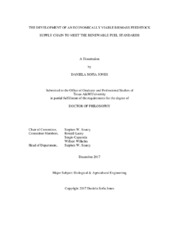| dc.contributor.advisor | Searcy, Stephen W | |
| dc.creator | Jones, Daniela Sofia | |
| dc.date.accessioned | 2018-09-21T15:27:54Z | |
| dc.date.available | 2018-09-21T15:27:54Z | |
| dc.date.created | 2017-12 | |
| dc.date.issued | 2017-12-05 | |
| dc.date.submitted | December 2017 | |
| dc.identifier.uri | https://hdl.handle.net/1969.1/169586 | |
| dc.description.abstract | This dissertation addresses the challenge to develop an economically viable biomass feedstock supply chain (SCh) that is able to provide feedstock under a range of operating conditions and meet the national renewable fuel targets for cellulosic fuels. This goal requires advances on a number of topics related to the structure of the feedstock logistics and the unit operations utilized to collect biomass. An assessment of the underlying assumptions for the range of conditions across the US was performed to determine their influence on perennial grasses predicted by DOE. Potential perennial grass production was overestimated in 2011 nationwide by 8-11% and 36-87% in TX. These overestimations are still present in the 2016 report, as perennial grasses are still predicted to grow on cropland with low rainfall levels. The revised total herbaceous biomass predicted exceeded the national targets, but the geographical location of biomass production changed. Overestimating biomass totals affects sustainability policies and planning. The revised predictions were used to determine the structure of the likely biomass feedstock SCh and quantify potential accessible and economically stranded herbaceous biomass in the US. Of the total nationwide available biomass, 78% could be accessed by biorefineries and 12% by depots, leaving 10% as stranded biomass. In total, 161 million Mg per year of feedstock delivered to 77 biorefineries (with capacities >2,000 Mg per day) around the US and 22.7 million Mg per year delivered to 171 depots (with capacities >240 Mg per day). This translates into 65.3 billion liters of advanced biofuels, enough to meet the targeted 60 billion liters of advanced cellulosic biofuel in the RFS2. A simulation tool was developed to evaluate an experimental module-based biomass collection system of corn stover in TX and IA and of switchgrass in Iowa and Tennessee, the BioMass Optimized Delivery System (BioMODS). Considering a grower payment of $ 29.77 per DMg, BioMODS costs were $90.82 and $71.63 for corn stover in TX and IA; and, $69.19 and $66.29 for switchgrass in IA and TN. The BioMODS system met the DOE goal of $88.2 per DMg and was proven more cost-effective than some studies presented DOE (with exception of the TX case study). | en |
| dc.format.mimetype | application/pdf | |
| dc.language.iso | en | |
| dc.subject | biomass | en |
| dc.subject | biofuels | en |
| dc.subject | GIS | en |
| dc.subject | supply chain | en |
| dc.subject | biorefinery | en |
| dc.subject | depots | en |
| dc.subject | switchgrass | en |
| dc.subject | agricultural economics | en |
| dc.title | The Development of an Economically Viable Biomass Feedstock Supply Chain to Meet the Renewable Fuel Standards | en |
| dc.type | Thesis | en |
| thesis.degree.department | Biological and Agricultural Engineering | en |
| thesis.degree.discipline | Biological and Agricultural Engineering | en |
| thesis.degree.grantor | Texas A & M University | en |
| thesis.degree.name | Doctor of Philosophy | en |
| thesis.degree.level | Doctoral | en |
| dc.contributor.committeeMember | Lacey, Ronald | |
| dc.contributor.committeeMember | Capareda, Sergio | |
| dc.contributor.committeeMember | Wilhelm, Wilbert | |
| dc.type.material | text | en |
| dc.date.updated | 2018-09-21T15:27:55Z | |
| local.etdauthor.orcid | 0000-0002-4285-7630 | |


